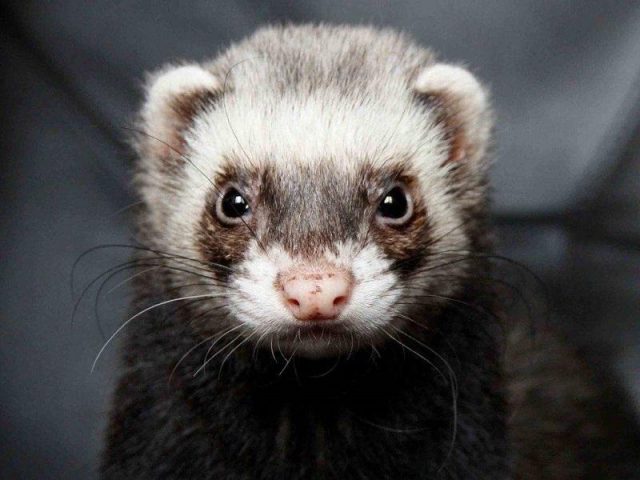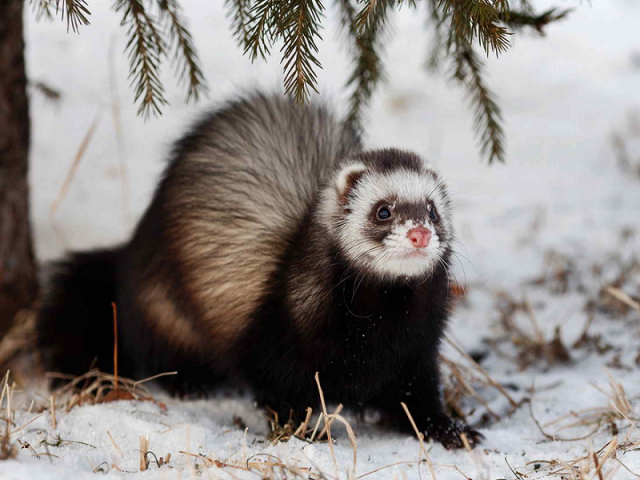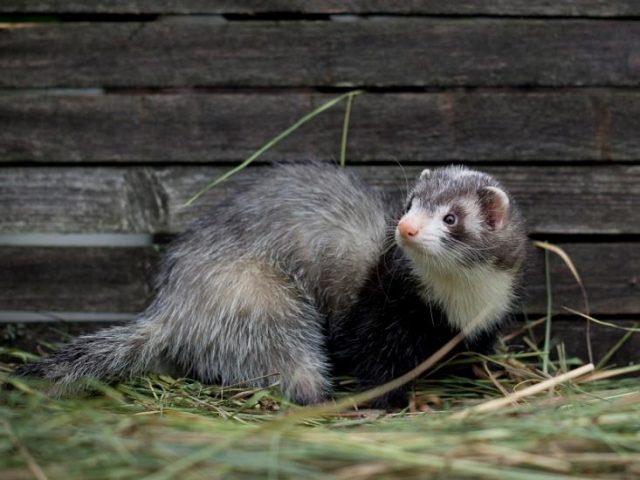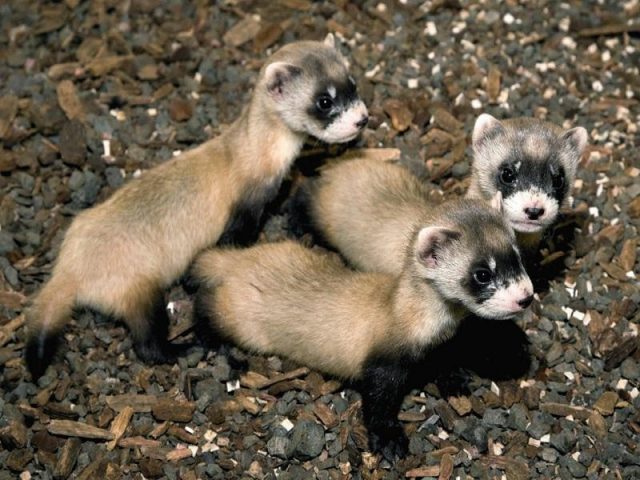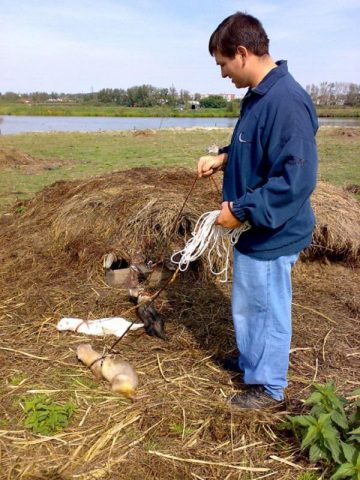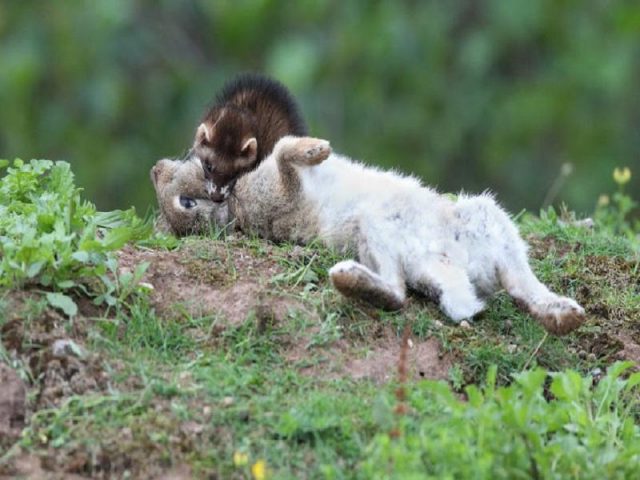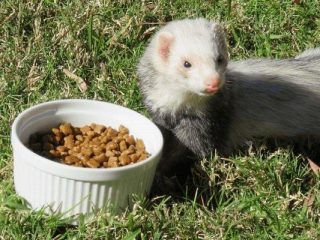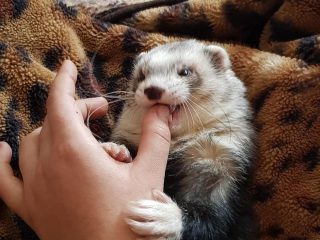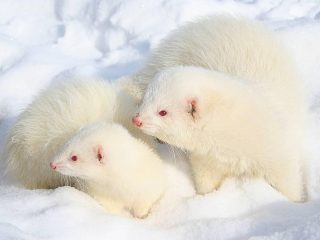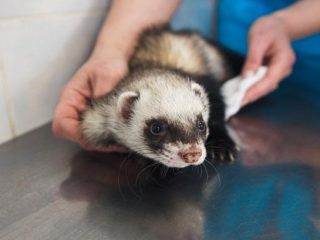Content
The wood ferret is a carnivorous mammal. He is kept as a pet. The animal gets used to the person, shows activity, friendliness, and playfulness. But it is worth remembering that a wild ferret is a predator, behaving appropriately in times of danger: using teeth, liquid from the anal glands with a strong odor.
Knowledge of habits, feeding habits, and habitat helps to better understand the behavior and character of a predator.
What does a wild ferret look like?
The forest, black or common ferret belongs to the mustelidae family, a class of carnivorous mammals.
The appearance of the animal does not differ from its relatives in the family, but there are individual features:
- Color. The main color is brown-black. Paws, back, tail, muzzle are dark. There are white marks on the ears, chin, and forehead. The fur on the belly and sides is lighter. In winter, the color of the animal is brighter and darker than in summer. The color options for the black ferret are red and albino.
- Wool. The animal's fur is shiny, long (6 cm), not thick. Summer - dull, sparse, winter - fluffy, black.
- Head. Oval in shape, flattened on the sides, smoothly turning into a flexible long neck.
- Ears. The base is wide, the height is average, the ends are rounded.
- Eyes. Brown, small, shiny.
- Body. The body of the forest animal is flexible, elongated, 40 cm long, mobile, allowing it to penetrate narrow crevices and burrows.
- Paws. The limbs of a wild ferret are short and thick (6 cm), which do not interfere with its rapid movement. Paws with five toes, sharp claws, and small membranes. Strong limbs allow the animal to dig the ground.
- Tail. Fluffy, is ¼ the length of the predator.
- Weight. The indicator varies depending on the time of year. The maximum weight of the forest ferret is in the fall. At this time, animals gain weight, storing fat for the winter. Males weigh 2 kg, females – 1 kg.
In numerous photos of wild ferrets you can see animals with different shades of fur and sizes. Characteristics and basic standards are the same for all predators.
Habits of forest ferrets
When describing the forest ferret, the isolation of the animal’s life is noted. Communication with relatives occurs during mating.
A forest animal has a personal habitat for living and hunting. The territory area reaches 2.5 hectares, less for females. Domains intersect and extend into the territories of other males. The stranger learns that the area is occupied by the marks left by the forest ferret.
The animal makes its home in a secluded place, in a pile of branches, under an old stump. The predator digs a hole with a short opening and makes a nest for resting. If a ferret is scared off by a person or forest animals, it looks for something new to put in its home.
The predator sleeps during the daytime and goes out hunting at night. In the absence of food, it moves away long distances. In bad weather he sits in a hole for days.
A forest animal that does not have time to return home at dawn hides until dusk in badger, hare, or previously dug holes.
The wild forest ferret is fearless and aggressive. A meeting with a large predator does not stop him. He boldly rushes into battle.
The predator is merciless towards its victims. Once in the chicken coop and eating one chicken, the rest will be strangled. Under natural conditions, the animal acts similarly.
Where does a ferret live in the wild?
The wild forest ferret makes its home in a clearing, forest edge or in sparse vegetation. The place is usually located near rivers, lakes, and reservoirs. The predator's lifestyle is sedentary. He becomes attached to a specific place and arranges his burrow with enviable care. The ferret drags leaves and grass into the “bedroom” and rolls it into a hollow ball with a diameter of 25 cm, where he sleeps. If it gets hot, the animal removes the nest from the hole, and with the onset of cold, the animal increases the bedding.
In winter, when it is difficult to get food, the forest predator settles closer to people: in cellars, attics, haystacks, barns. In such places he hunts rats, rabbits, and chickens.
Where does the ferret live in Russia?
The forest ferret lives in Eurasia. The main part of the population is located in the European part of the Russian Federation - from the Urals to the western borders of the country. The animal does not live in North Karelia, the Caucasus, and the Volga region. The size of an animal's population depends on the availability of food for it. There is a large population of individuals living in the Smolensk region.
Population of black ferrets
In addition to the territory of Russia, the forest ferret lives in England. The British raptor population is large. The animal settled in Finland and northwest Africa.
The predator was brought to New Zealand to fight rats and mice. Soon it took root in the new place and began to threaten the destruction of the indigenous representatives of the New Zealand fauna.
Taking photos and videos of ferrets in the wild is difficult: the population is constantly declining. The predator has durable, beautiful fur, due to the extraction of which mass destruction led to a critical decrease in the number of individuals. Today, the forest ferret is listed in the Red Book; hunting for it is prohibited.
What do ferrets eat in the wild?
In the wild, the ferret eats animal food, but is of little interest to plant food.
The predator is agile; shrews, mice, moles and other rodents easily become its prey.
The animal loves to feast on frogs, newts, and lizards. Prefers hedgehog meat and easily copes with prickly opponents. Does not disdain snakes, even poisonous ones.
The forest ferret destroys nests, eats eggs, and destroys birds.
The animal is capable of catching a muskrat or a hare. The ability to silently sneak up helps the predator to hunt upland game. Keeps animals and insects out.
In the village it penetrates into chicken coops and goose coops, where it eats and strangles poultry. The animal is able to make provisions for the winter by storing its prey in a secluded place.
A photo of a wild ferret feeding on fish can only be taken at home: under natural conditions it is difficult for the animal to catch it.
The predator’s gastrointestinal tract is unable to digest fruits, berries, and grass; it rarely consumes vegetation. It makes up for the lack of fiber by eating the stomach contents of killed herbivores.
During the warm season there is no shortage of food. From September, the ferret intensively stores fat.In winter, getting food is more difficult for him; he has to tear up the snow, catch mice, and attack hazel grouse and black grouse spending the night in the snowdrifts.
When there is no food, the animal does not disdain carrion and waste thrown out by humans.
Competition between individuals is not developed, since strong males hunt large prey, and weaker predators hunt small prey.
Features of reproduction
Wild ferrets become sexually mature by the age of one year. Until spring he lives separately, as a hermit. In April-May, in the second half of June, the rut begins. Forest predators do not perform special mating rituals. Males behave aggressively when mating. The female has teeth marks on her neck and a frayed withers. Gestation lasts 40 days, after which 4 to 12 cubs are born, weighing 10 g. Ferrets are born blind and helpless. They grow and develop quickly. They mature by the month, their mother feeds them milk for seven weeks, then gradually switches them to meat. Three months later, the whole brood, together with their mother, young predators go hunting, helping her and learning all the intricacies. At this moment, females desperately protect the brood from danger. Young people stay with the family until autumn. It is easy to distinguish the young from the parent by the juvenile “mane”, long hair on the back of the neck.
In autumn, young individuals grow to the size of adults, reaching a weight of 2.5 kg. By winter, the animals grow up to half a meter in length. From this time on, independent life begins for predators.
Enemies of wild ferrets
The habitats of the forest ferret are inhabited by large, strong predators that can harm or eat it.
In open areas, the animal has nowhere to hide from the wolf, which can easily catch up.Foxes more often attack wild ferrets in winter, during times of hunger, when mice cannot be reached and hares are difficult to catch.
Birds of prey - eagle owls, owls - are ready to grab him at night. During the day, falcons and golden eagles hunt animals.
They leave no chance for the ferret to live for the lynx. When a forest predator moves closer to human habitation, dogs pose a threat.
Civilization causes harm to the population. By developing territories, cutting down forests, and laying roads, people force the animal to leave its usual environment. Uncontrolled hunting leads to a reduction in the population of small animals that provide food for ferrets, and then the animal leaves its place of residence. Many animals fall under the wheels of vehicles. The number of predators is also decreasing due to the hunt for valuable skins.
The average lifespan of animals in nature is 5 years. If properly cared for, a domesticated forest ferret lives 12 years.
Despite the swiftness of the animal, a person who decides to make a video of a wild ferret can catch up with it. At the same time, we must remember about the behavior of even a pet in a moment of danger. It is easy to get a foul-smelling stream from the anal glands of a predator in your face.
Interesting facts about forest ferrets
The forest ferret has become a pet today: along with cats and dogs, it lives near people. There are many interesting facts associated with it:
- the animals were domesticated 2000 years ago, they were used for hunting rabbits;
- translated from Latin, the word ferret means “thief”;
- the animal's heart rate is 240 beats per minute;
- a sensitive sense of smell and acute hearing compensate for the predator’s weak vision;
- the forest ferret sleeps up to 20 hours a day and is difficult to wake up;
- animals run equally skillfully both in the usual way and backwards;
- domestic and wild ferrets do not live in peace and harmony;
- in an hour, a forest animal is able to dig a hole 5 meters deep;
- can penetrate into any gap thanks to its flexible spine;
- at home, predators can sleep in a small box;
- When attacked, a wild ferret performs a war dance - it jumps, puffs up its tail, arches its back, hisses;
- a newborn baby fits in a teaspoon;
- the percentage of albinos is large, animals have red eyes;
- forest ferrets know how to swim, but do not like to do it;
- in New York and California it is prohibited to keep them at home: escaped individuals can cause damage to the environment by forming colonies;
- In 2000, a ten-day-old girl in Wisconsin was attacked by domestic ferrets and was rescued by her dog. It is believed that babies smell like milk, predators see them as prey;
- the neck muscles of animals are so developed that a small forest animal is able to drag a rabbit;
- the flexibility of the wild ferret's body, the ability to penetrate any crevice, was used in the construction of Boeings and the Hadron Collider, animals stretched wires in hard-to-reach places;
- Leonardo da Vinci's Lady with an Ermine actually depicts an albino ferret.
Conclusion
The forest ferret has long ceased to be just a wild animal. It lives next to humans and, with proper care, produces offspring. When socialized at an early age, he loves contacts with people, to whom he later gets used to.
The forest ferret is a bright representative of wild nature, being its decoration. It is necessary to preserve the animal population so that the species does not disappear from the face of the earth without the possibility of recovery.
If the animal is wild, it is difficult to take a photo of the ferret, but this is not the most important thing. Enough filming at home.Wild animals should remain so.
